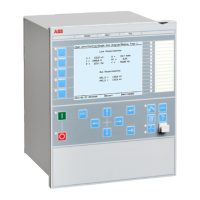percentage of the phase-to-earth voltage is definitely higher than 1% (minimum
3U
0
>UPolMin setting) as a verification.
RNPol, XNPol: The zero-sequence source is set in primary ohms as base for the
current polarizing. The polarizing voltage is then achieved as 3I
0
· ZNpol. The
ZNpol can be defined as (ZS
1
-ZS
0
)/3, that is the earth return impedance of the
source behind the protection. The maximum earth-fault current at the local source
can be used to calculate the value of ZN as U/(√3 · 3I
0
) Typically, the minimum
ZNPol (3 · zero sequence source) is set. The setting is in primary ohms.
When the dual polarizing method is used, it is important that the setting INx> or
the product 3I
0
· ZNpol is not greater than 3U
0
. If so, there is a risk for incorrect
operation for faults in the reverse direction.
IPolMin: is the minimum earth-fault current accepted for directional evaluation.
For smaller currents than this value, the operation will be blocked. A typical setting
is 5-10% of IB.
UPolMin: Minimum polarization (reference) polarizing voltage for the directional
function, given in % of UBase/√3.
IN>Dir: Operate residual current release level in % of IB for directional
comparison scheme. The setting is given in % of IB and must be set below the
lowest INx> setting, set for the directional measurement. The output signals,
STFW and STRV can be used in a teleprotection scheme. The appropriate signal
should be configured to the communication scheme block.
7.2.3.2 2nd harmonic restrain
M15282-90 v6
If a power transformer is energized there is a risk that the current transformer core
will saturate during part of the period, resulting in a transformer inrush current.
This will give a declining residual current in the network, as the inrush current is
deviating between the phases. There is a risk that the residual overcurrent function
will give an unwanted trip. The inrush current has a relatively large ratio of 2nd
harmonic component. This component can be used to create a restrain signal to
prevent this unwanted function.
At current transformer saturation a false residual current can be measured by the
protection. Here the 2
nd
harmonic restrain can prevent unwanted operation as well.
2ndHarmStab: The rate of 2nd harmonic current content for activation of the 2nd
harmonic restrain signal. The setting is given in % of the fundamental frequency
residual current.
7.2.3.3 Parallel transformer inrush current logic
M15282-97 v6
In case of parallel transformers there is a risk of sympathetic inrush current. If one
of the transformers is in operation, and the parallel transformer is switched in, the
asymmetric inrush current of the switched-in transformer will cause partial
Section 7 1MRK 505 388-UEN B
Current protection
106 Busbar protection REB650 2.2 IEC
Application manual

